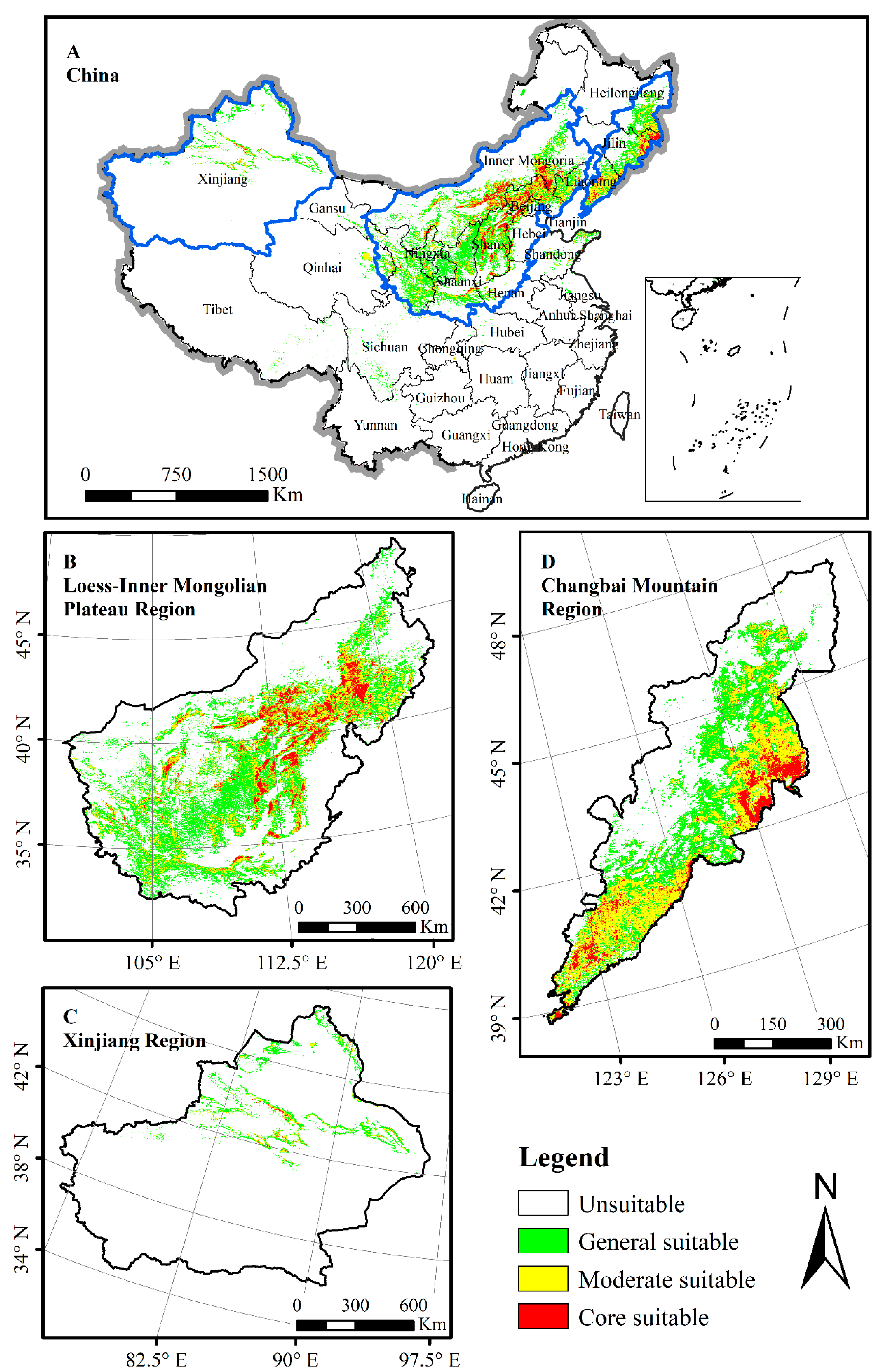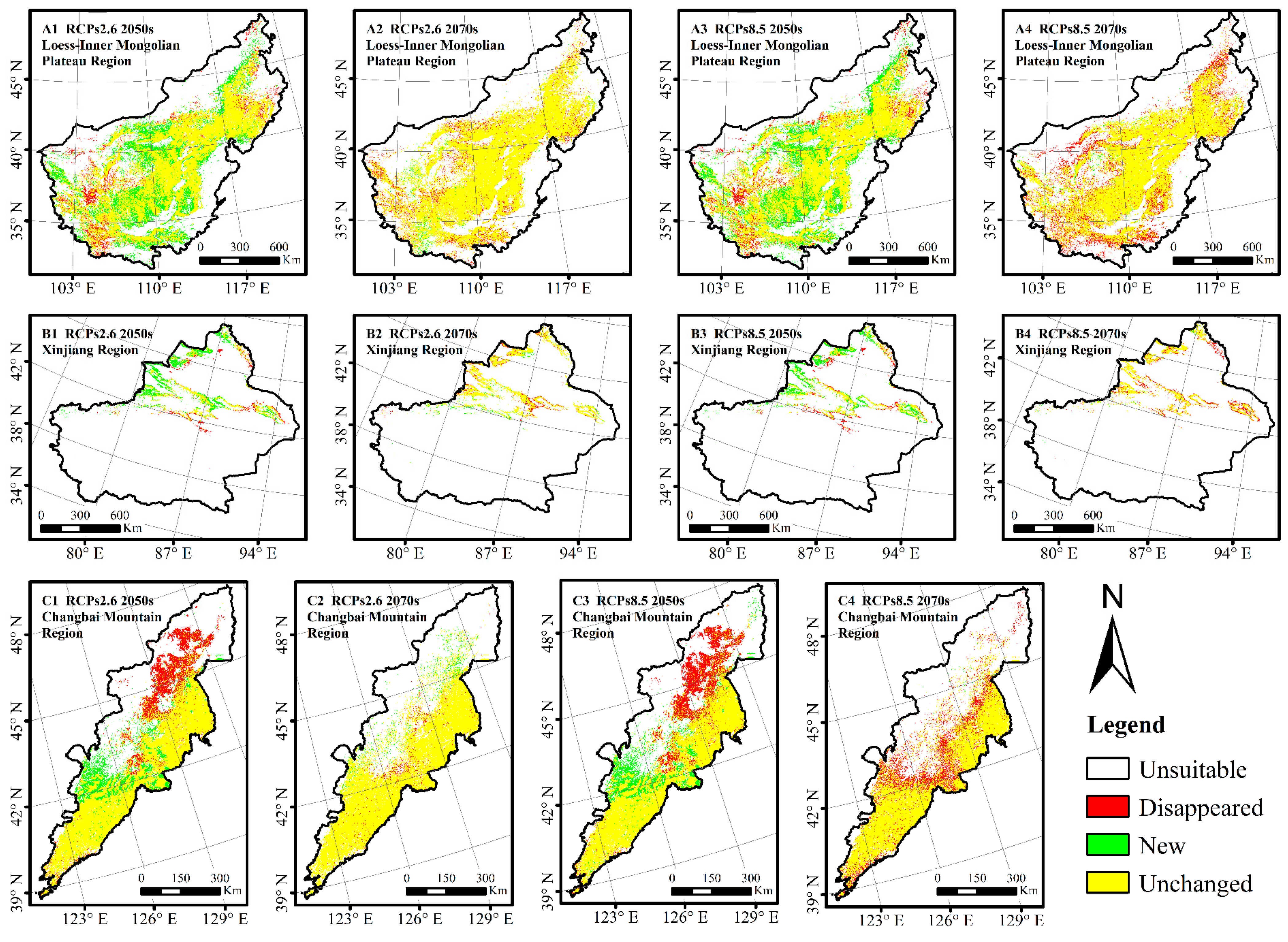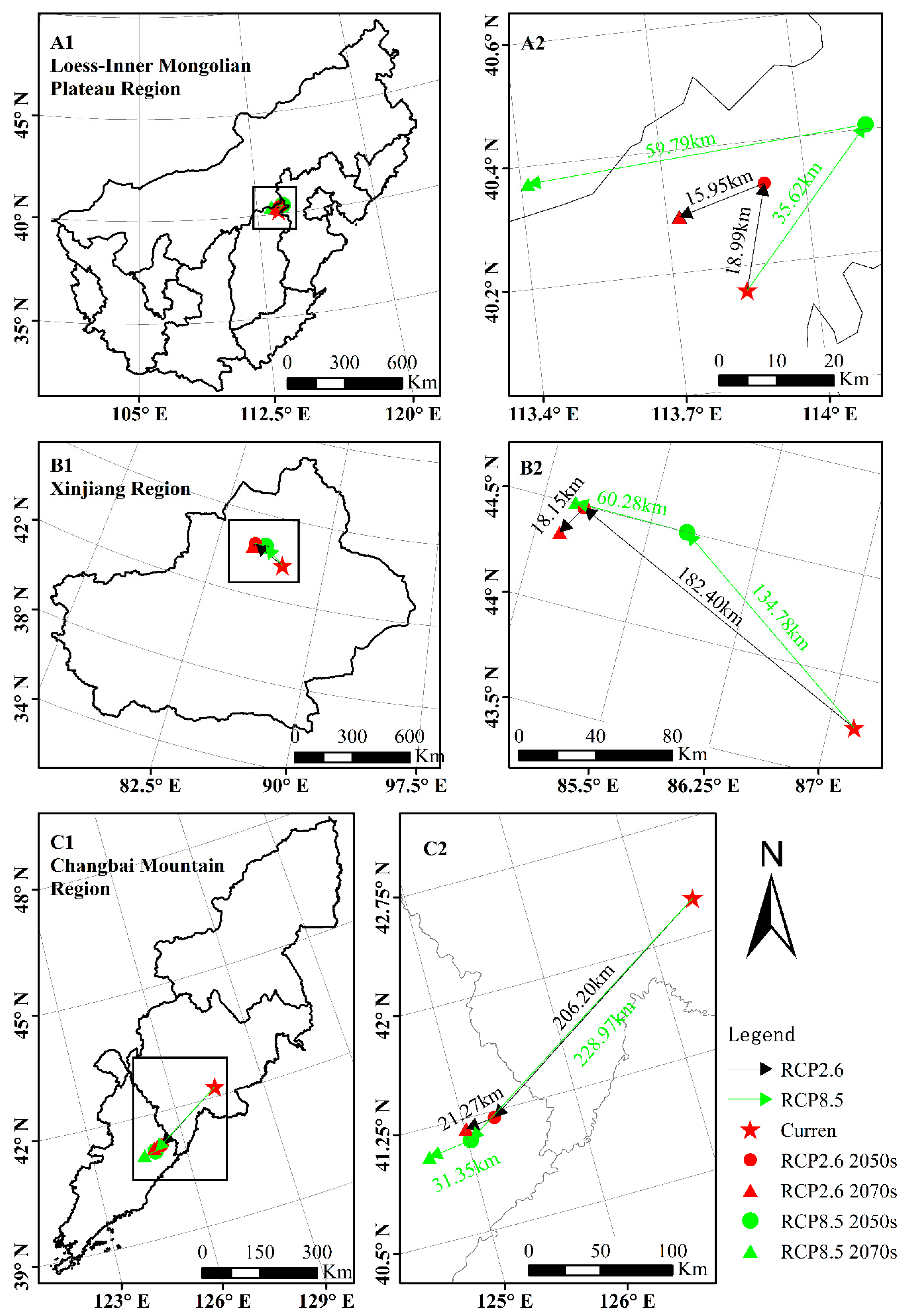The Potential Distribution of Juniperus rigida Sieb. et Zucc. Vary Diversely in China under the Stringent and High GHG Emission Scenarios Combined Bioclimatic, Soil, and Topographic Factors
Abstract
:1. Introduction
2. Materials and Methods
2.1. Collection and Processing of Species Distribution Data
2.2. Collection and Selection Climate, Soil, and Topographical Data
2.3. Model Establishment and Accuracy Test
2.4. Potential Habitat Assessment
2.5. The Shift of the Core Distribution Centroid
3. Results
3.1. Model Evaluation and Important Variables
3.2. The Potential Distribution of J. rigida under the Current Climate
3.3. Diversified Changes of Suitable Habitat Areas among Different Regions under Future Climate
3.4. Varied Spatial Shifts of Core Distribution in China under the Future Climate Scenario
4. Discussion
4.1. Suitable Distribution in Current Climate Scenario
4.2. Ecological Variables Influencing the Spatial Distribution Pattern of J. rigida
4.3. Prospective Change on Distribution in the Face of Climate Warming
5. Conclusions
Author Contributions
Funding
Data Availability Statement
Conflicts of Interest
References
- Şahin, Ü.A.; Onat, B.; Ayvaz, C. Climate Change and Greenhouse Gases in Turkey. In Recycling and Reuse Approaches for Better Sustainability; Balkaya, N., Guneysu, S., Eds.; Environmental Science and Engineering; Springer: Cham, Switzerland, 2019; pp. 201–214. [Google Scholar]
- Pachauri, K.; Meyer, A. Climate Change 2014. Synthesis Report. Environ. Policy Collect. 2014, 27, 408. [Google Scholar] [CrossRef]
- Moraitis, M.L.; Valavanis, V.D.; Karakassis, I. Modelling the effects of climate change on the distribution of benthic indicator species in the Eastern Mediterranean Sea. Sci. Total Environ. 2019, 667, 16–24. [Google Scholar] [CrossRef]
- Wilson, K.L.; Skinner, M.A.; Lotze, H.K. Projected 21st-century distribution of canopy-forming seaweeds in the Northwest Atlantic with climate change. Divers. Distrib. 2019, 25, 582–602. [Google Scholar] [CrossRef] [Green Version]
- Nogué, S.; Rull, V.; Vegas-Vilarrúbia, T. Modeling biodiversity loss by global warming on pantepui, northern South America: Projected upward migration and potential habitat loss. Clim. Chang. 2009, 94, 77–85. [Google Scholar] [CrossRef]
- Yi, Y.J.; Zhou, Y.; Cai, Y.P.; Yang, W.; Li, Z.W.; Zhao, X. The influence of climate change on an endangered riparian plant species: The root of riparian Homonoia. Ecol. Indic. 2018, 92, 40–50. [Google Scholar] [CrossRef]
- Pinedo-Alvarez, C.; Renteria-Villalobos, M.; Aguilar-Soto, V.; Vega-Mares, J.H.; Melgoza-Castillo, A. Distribution dynamics of Picea chihuahuana Martínez populations under different climate change scenarios in Mexico. Glob. Ecol. Conserv. 2019, 17, e00559. [Google Scholar] [CrossRef]
- Grinnell, J. The niche-relationships of the California Thrasher. Auk 1917, 34, 427–433. [Google Scholar] [CrossRef]
- Elton, C.S. Animal Ecology; University of Chicago Press: Chicago, IL, USA, 1927. [Google Scholar]
- Hutchinson, G.E. Concluding remarks. Cold Spring Harb. Sym. 1957, 22, 415–427. [Google Scholar] [CrossRef]
- Busby, J.R. BIOCLIM: A bioclimate analysis and prediction system. Plant Prot. Q. 1991, 6, 8–9. [Google Scholar]
- Carpenter, G.; Gillison, A.N.; Winter, J. DOMAIN: A flexible modelling procedure for mapping potential distributions of plants and animals. Biodivers. Conserv. 1993, 2, 667–680. [Google Scholar] [CrossRef]
- Stockwell, D.; Peters, D. The GARP modelling system: Problems and solutions to automated spatial prediction. Int. J. Geogr. Inf. Sci. 1999, 13, 143–158. [Google Scholar] [CrossRef]
- Phillips, S.B.; Aneja, V.P.; Kang, D.; Arya, S.P. Modelling and analysis of the atmospheric nitrogen deposition in North Carolina. Int. J. Glob. Environ. Issues 2006, 6, 231–252. [Google Scholar] [CrossRef] [Green Version]
- Pearson, R.G.; Raxworthy, C.J.; Nakamura, M.; Peterson, A.T. Predicting species distributions from small numbers of occurrence records: A test case using cryptic geckos in Madagascar. J. Biogeogr. 2007, 1, 102–117. [Google Scholar] [CrossRef]
- Elith, J.; Graham, C.H.; Anderson, R.P.; Dudik, M.; Ferrier, S.; Guisan, A.; Hijmans, R.J.; Huettmann, F.; Leathwick, J.R.; Lehmann, A.; et al. Novel methods improve prediction of species’ distributions from occurrence data. Ecography 2006, 29, 129–151. [Google Scholar] [CrossRef] [Green Version]
- Tsoar, A.; Allouche, O.; Steinitz, O.; Rotem, D.; Kadmon, R. A comparative evaluation of presence-only methods for modelling species distribution. Divers. Distrib. 2007, 13, 397–405. [Google Scholar] [CrossRef]
- Qin, H.N.; Yang, Y.; Dong, S.Y.; He, Q.; Jia, Y.; Zhao, L.N.; Yu, S.X.; Liu, B.; Yan, Y.H.; Xiang, J.Y.; et al. Threatened Species List of China’s Higher Plants. Biodivers. Sci. 2017, 25, 696–744. [Google Scholar] [CrossRef] [Green Version]
- Liu, Y.H.; Ma, Z.H. Influencing factors on seed germination of Juniperus rigida from Helan Mountain. J. Northwest A F Univ. 2016, 44, 62–70. [Google Scholar]
- Gelviz-Gelvez, S.M.; Pavón, N.P.; Illoldi-Rangel, P.; Ballesteros-Barrera, C. Ecological niche modeling under climate change to select shrubs for ecological restoration in Central Mexico. Ecol. Eng. 2015, 74, 302–309. [Google Scholar] [CrossRef]
- Molloy, S.W.; Davis, R.A.; Van Etten, E.J. Species distribution modelling using bioclimatic variables to determine the impacts of a changing climate on the western ringtail possum (Pseudocheirus occidentals; Pseudocheiridae). Environ. Conserv. 2014, 41, 176–186. [Google Scholar] [CrossRef]
- Pachauri, R.K.; Allen, M.R.; Barros, V.R.; Broome, J.; Cramer, W.; Christ, R.; Church, J.A.; Clarke, L.; Dahe, Q.; Dasgupta, P.; et al. Climate Change 2014: Synthesis Report; Contribution of Working Groups I, II and III to the Fifth Assessment Report of the Intergovernmental Panel on Climate Change; Pachauri, R., Meyer, L., Eds.; IPCC: Geneva, Switzerland, 2014; p. 151. Available online: http://hdl.handle.net/10013/epic.45156.d001 (accessed on 13 April 2015).
- Vuuren, D.P.V.; Johannes, F.; Lamarque, J.F.; Riahi, K.; Rose, S.; Smith, S.; Hibbard, K. Work Plan for Data Exchange between the Integrated Assessment and Climate Modeling Community in Support of Phase-0 of Scenario Analysis for Climate Change Assessment (Representative Community Pathways); IPCC: Geneva, Switzerland, 2008; Available online: http://www.aimes.ucar.edu/docs/RCPhandshake.pdf (accessed on 6 October 2008).
- Weyant, J.; Azar, C.; Kainuma, M.; Kejun, J.; Nakicenovic, N.; Shukla, P.R.; Rovere, E.L.; Yohe, G. Report of 2.6 Versus 2.9 watts/m2 RCPP Evaluation Panel; IPCC: Geneva, Switzerland, 2009; p. 82. Available online: http://www.ipcc.ch/meetings/session30/inf6.pdf (accessed on 31 March 2009).
- Masson-Delmotte, V.; Zhai, P.; Pörtner, H.O.; Roberts, D.; Skea, J.; Shukla, P.R.; Pirani, A.; Moufouma-Okia, W.; Péan, C.; Pidcock, R.; et al. Summary for Policymakers. In Global Warming of 1.5 °C; An IPCC Special Report on the Impacts of Global Warming of 1.5 °C above Pre-Industrial Levels and Related Global Greenhouse Gas Emission Pathways, in the Context of Strengthening the Global Response to the Threat of Climate Change, Sustainable Development, and Efforts to Eradicate Poverty; World Meteorological Organization: Geneva, Switzerland, 2018; Available online: https://www.researchgate.net/publication/329866816_Summary_for_Policymakers_In_Global_warming_of_15C_An_IPCC_Special_Report (accessed on 1 October 2018).
- Wang, M.H.; Li, H.L.; Sun, X.T. Quantitative evaluation on the inter-annual and inter-decadal precipitation variability simulated by sixCMIP5 models of china. Meteorol. Mon. 2018, 44, 634–644. [Google Scholar] [CrossRef]
- Zhang, L.; Ding, Y.H.; Wu, T.W.; Xin, X.G.; Zhang, Y.W.; Xu, Y. The 21st century annual mean surface air temperature change and the 2 °C warming threshold over the globe and China as projected by the CMIPS models. Acta Meteorol. Sin. 2013, 71, 1047–1060. [Google Scholar] [CrossRef]
- Morales, N.S.; Fernández, I.C.; Baca-González, V. MaxEnt’s parameter configuration and small samples: Are we paying attention to recommendations? A systematic review. PeerJ 2017, 5, e3093. [Google Scholar] [CrossRef]
- Phillips, S.J.; Dudik, M. Modeling of species distributions with Maxent: New extensions and a comprehensive evaluation. Ecography 2008, 31, 161–175. [Google Scholar] [CrossRef]
- Rong, Z.; Zhao, C.; Liu, J.; Gao, Y.; Zang, F.; Guo, Z.; Mao, Y.; Wang, L. Modeling the Effect of Climate Change on the Potential Distribution of Qinghai Spruce (Picea crassifolia Kom.) in Qilian Mountains. Forests 2019, 10, 62. [Google Scholar] [CrossRef] [Green Version]
- Bewick, V.; Cheek, L.; Ball, J. Statistics review 13: Receiver operating characteristic curves. Crit. Care 2004, 8, 508–512. [Google Scholar] [CrossRef] [PubMed] [Green Version]
- Davies, T.J.; Purvis, A.; Gittleman, J.L. Quaternary climate change and the geographic ranges of mammals. Am. Nat. 2009, 174, 297–307. [Google Scholar] [CrossRef] [PubMed]
- Phillips, S.J.; A Brief Tutorial on Maxent. Exercise, American Museum of Natural History, New York. 2017. Available online: http://ncep.amnh.org/linc/linc_download.php?component_id=39 (accessed on 16 July 2021).
- Janitza, S.; Strobl, C.; Boulesteix, A.L. An AUC-based permutation variable importance measure for random forests. BMC Bioinf. 2013, 14, 119. [Google Scholar] [CrossRef] [Green Version]
- Flora of China Editorial Committee. Flora of China; Science Press and Missouri Botanical Garden Press: Beijing, China, 2006; Volume 4, p. 1999. [Google Scholar]
- Li, T.B.; Zhang, Y.F.; Li, D.W.; Wang, C.Y. Seed germination performance of Juniperus rigida in different regions of the Loess Plateau and its relation with ecological factors. Agric. Res. Arid. Areas 2015, 3, 139–143. [Google Scholar] [CrossRef]
- China forest Editorial Committee. China Forest; China Forestry Press: Beijing, China, 2000. [Google Scholar]
- Li, K.; Zheng, B.Q.; Wang, Y.B.; BU, W.S. Numeric dynamics of natural populations of Paeonia delavayi (Paeoniaceae). Chin. J. Plant Ecol. 2012, 36, 522–529. [Google Scholar] [CrossRef]
- Philip, M.P.M. Physiological Studies on Floral Bud Development and Flowering Mechanism in Tree Peony (Doctoral dissertation); Beijing Forestry University: Beijing, China, 2011. [Google Scholar]
- Baskin, C.C.; Baskin, J.M. Seeds: Ecology Biogeography and Evolution of Dormancy and Germination, 2nd ed.; Academic Press: San Diego, CA, USA, 2014. [Google Scholar]
- Li, X.Y.; He, L. Preliminary study of techniques for growing seedlings of Juniperus rigida. For. Shaanxi 2011, 3, 36. [Google Scholar]
- Root, T.L.; Price, J.T.; Hall, K.R.; Schneider, S.H.; Rosenzweig, C.; Pounds, J.A. Fingerprints of global warming on wild animals and plants. Nature 2003, 421, 57–60. [Google Scholar] [CrossRef] [PubMed]
- Hoffmann, A.A.; Sgro, C.M. Climate change and evolutionary adaptation. Nature 2011, 470, 479–485. [Google Scholar] [CrossRef]
- Hu, X.G.; Jin, Y.; Wang, X.R.; Mao, J.F.; Li, Y. Predicting impacts of future climate change on the distribution of the widespread conifer Platycladus orientalis. PLoS ONE 2015, 10, e0132326. [Google Scholar] [CrossRef] [PubMed]
- Lenoir, J.; Gégout, J.C.; Marquet, P.A.; Ruffray, P.; Brosse, H. A significant upward shift in plant species optimum elevation during the 20th century. Science 2008, 320, 1768–1771. [Google Scholar] [CrossRef] [PubMed]
- Bertrand, R.; Lenoir, J.; Piedallu, C.; Riofrío-Dillon, G.; De Ruffray, P.; Vidal, C.; Pierrat, J.; Gégout, J. Changes in plant community composition lag behind climate warming in lowland forests. Nature 2011, 479, 517–520. [Google Scholar] [CrossRef]
- Grabherr, G.; Gottfried, M.; Pauli, H. Climate effects on mountain plants. Nature 1994, 369, 448. [Google Scholar] [CrossRef]
- Zhou, M.Z.; Zhou, G.S.; Lv, X.M.; Zhou, L.; Ji, Y.H. Projection of temperature and precipitation changes over China under global warming of 1.5 and 2 °C. Acta Meteorol. Sin. 2019, 77, 728–744. [Google Scholar] [CrossRef]
- Woodward, F.I.; Williams, B.G. Climate and plant distribution at global and local scales. In Theory and Models in Vegetation Science; Prentice, I.C., van der Maarel, E., Eds.; Advances in vegetation science; Springer: Dordrecht, The Netherlands, 1987; Volume 8. [Google Scholar] [CrossRef]
- Ma, B.; Sun, J. Predicting the distribution of Stipa purpurea across the Tibetan Plateau via the MaxEnt model. BMC Ecol. 2018, 18, 10. [Google Scholar] [CrossRef] [Green Version]
- Xu, M.H.; Xue, X. Analysis on the effects of climate warming on growth and phenology of alpine plants. J. Arid Land Resour. Environ. 2013, 27, 137–141. [Google Scholar] [CrossRef]
- Jiang, D.B.; Fu, Y.H. Climate change over China with a 2 °C global warming. Chin. J. Atmos. Sci. 2012, 36, 234–246. [Google Scholar] [CrossRef]
- Su, Q.H.; Zhou, R.J.; Ke, Z.J.; Liu, C.Z.; Du, L.M.; Yan, Y. Optimal weighted model for ensemble forecast of the surface air temperature in mainland China and its regional applications. J. Univ. Sci. Technol. China 2017, 48, 199–209. [Google Scholar] [CrossRef]




| Abbreviation | Variables Description | Percent Contribution (%) | Permutation Importance |
|---|---|---|---|
| Slo | Slope | 16.8763 | 7.3039 |
| Alt | Altitude | 15.7851 | 29.669 |
| MTDq | Mean Temperature of Driest Quarter | 12.8316 | 1.4061 |
| TAR | Temperature Annual Range | 11.6773 | 11.4124 |
| PWm | Precipitation of Wettest Month | 6.6254 | 0.7003 |
| SpH | Subsoil pH | 5.3958 | 1.2187 |
| PS | Precipitation Seasonality | 4.9589 | 3.4087 |
| RH | Relative Humidity | 3.9251 | 2.8779 |
| TS | Temperature Seasonality | 3.8679 | 5.0902 |
| Iso | Isothermality | 3.8106 | 9.43 |
| Ins | Insolation Hour | 3.3007 | 3.063 |
| Asp | Aspect | 2.1047 | 2.1337 |
| TpH | Topsoil pH | 1.9548 | 1.8882 |
| MDR | Mean Diurnal Range | 1.8851 | 3.2606 |
| AMT | Annual Mean Temperature | 1.4083 | 8.0216 |
| TTEX | Topsoil Texture | 1.2019 | 0.9042 |
| AWC | Available Water Content | 1.113 | 0.9102 |
| AP | Annual Precipitation | 0.6486 | 4.1459 |
| PCq | Precipitation of Coldest Quarter | 0.2826 | 1.3119 |
| SOC | Subsoil organic content | 0.1834 | 0.6614 |
| MTWm | Max Temperature of Warmest Month | 0.1526 | 1.1502 |
| TECE | Topsoil Electric Conductivity | 0.0105 | 0.0318 |
| Regions | General Distribution | Moderate Distribution | Core Distribution | Total | |||
|---|---|---|---|---|---|---|---|
| Area (104 km2) | Percentage (%) | Area (104 km2) | Percentage (%) | Area (104 km2) | Percentage (%) | Area (104 km2) | |
| China | 49.59 | 57.08 | 27.15 | 31.25 | 10.13 | 11.66 | 86.87 |
| Changbai Mountain region | 6.53 | 44.58 | 6.32 | 43.12 | 1.80 | 12.29 | 14.65 |
| Loess-Inner Mongolian Plateau Region | 34.95 | 56.93 | 18.43 | 30.02 | 8.01 | 13.04 | 61.39 |
| Xinjiang Region | 4.06 | 71.82 | 1.39 | 19.25 | 0.20 | 3.89 | 5.65 |
| Scenario | Type | Xinjiang Region (104 km2) | Loess-Inner Mongolian Platea Region (104 km2) | Changbai Mountain Region (104 km2) | |||
|---|---|---|---|---|---|---|---|
| 2050s | 2070s | 2050s | 2070s | 2050s | 2070s | ||
| Current | Total | 5.651 | 61.394 | 14.646 | |||
| RCP 2.6 | Disappeared | −1.348 | −1.329 | −5.789 | −7.253 | −2.887 | −2.891 |
| New | 4.012 | 3.580 | 18.434 | 14.237 | 2.057 | 2.055 | |
| Unchanged | 4.303 | 4.322 | 55.604 | 54.140 | 11.756 | 11.753 | |
| Total | 8.316 | 7.902 | 74.039 | 68.377 | 13.813 | 13.808 | |
| RCP 8.5 | Disappeared | −1.525 | −2.415 | −6.094 | −12.693 | −3.352 | −5.244 |
| New | 3.416 | 2.362 | 16.799 | 9.729 | 1.943 | 0.806 | |
| Unchanged | 4.126 | 3.236 | 55.300 | 48.701 | 11.284 | 9.392 | |
| Total | 7.542 | 5.598 | 72.099 | 58.430 | 13.227 | 10.198 | |
| Regions | Scenarios | Periods | Longitude | Latitude | Altitude (m) | Distance (km) |
|---|---|---|---|---|---|---|
| Changbai Mountain region | Current | 127.44° E | 42.24° N | 450 | —— | |
| RCP 2.6 | 2050s | 125.27° E | 41.21° N | 470 | 206.2 | |
| 2070s | 125.01° E | 41.18° N | 477 | 21.27 | ||
| RCP 8.5 | 2050s | 125.03° E | 41.10° N | 465 | 228.97 | |
| 2070s | 124.65° E | 41.06° N | 484 | 31.35 | ||
| Loess-Inner Mongolian Plateau Region | Current | 113.85° E | 40.16° N | 1518 | —— | |
| RCP 2.6 | 2050s | 113.91° E | 40.33° N | 1373 | 18.99 | |
| 2070s | 113.73° E | 40.29° N | 1464 | 15.95 | ||
| RCP 8.5 | 2050s | 114.14° E | 40.41° N | 1373 | 35.62 | |
| 2070s | 113.41° E | 40.37° N | 1618 | 59.79 | ||
| Xinjiang Region | Current | 87.17° E | 43.76° N | 2138 | —— | |
| RCP 2.6 | 2050s | 85.03 ° E | 44.49° N | 2004 | 182.4 | |
| 2070s | 84.91° E | 44.35° N | 2070 | 18.15 | ||
| RCP 8.5 | 2050s | 85.76° E | 44.50° N | 2099 | 134.78 | |
| 2070s | 84.97° E | 44.51° N | 2104 | 60.28 | ||
Publisher’s Note: MDPI stays neutral with regard to jurisdictional claims in published maps and institutional affiliations. |
© 2021 by the authors. Licensee MDPI, Basel, Switzerland. This article is an open access article distributed under the terms and conditions of the Creative Commons Attribution (CC BY) license (https://creativecommons.org/licenses/by/4.0/).
Share and Cite
Lv, Z.; Li, D. The Potential Distribution of Juniperus rigida Sieb. et Zucc. Vary Diversely in China under the Stringent and High GHG Emission Scenarios Combined Bioclimatic, Soil, and Topographic Factors. Forests 2021, 12, 1140. https://doi.org/10.3390/f12091140
Lv Z, Li D. The Potential Distribution of Juniperus rigida Sieb. et Zucc. Vary Diversely in China under the Stringent and High GHG Emission Scenarios Combined Bioclimatic, Soil, and Topographic Factors. Forests. 2021; 12(9):1140. https://doi.org/10.3390/f12091140
Chicago/Turabian StyleLv, Zhenjiang, and Dengwu Li. 2021. "The Potential Distribution of Juniperus rigida Sieb. et Zucc. Vary Diversely in China under the Stringent and High GHG Emission Scenarios Combined Bioclimatic, Soil, and Topographic Factors" Forests 12, no. 9: 1140. https://doi.org/10.3390/f12091140







